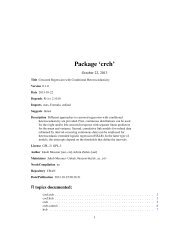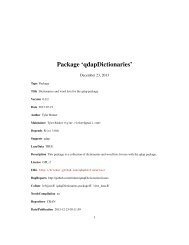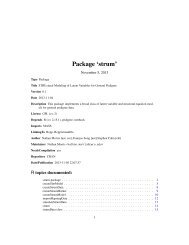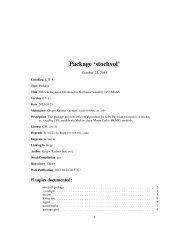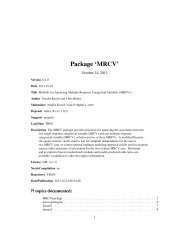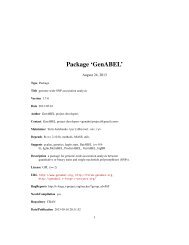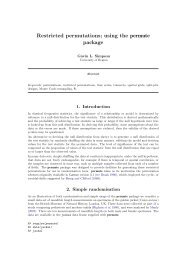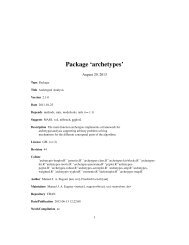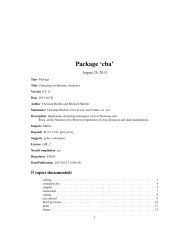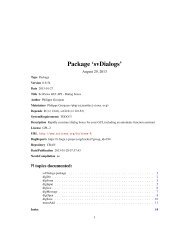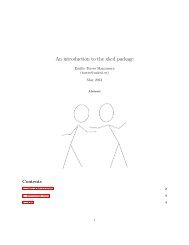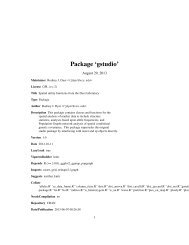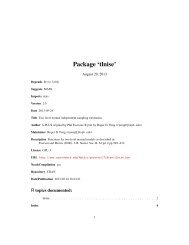Package 'GeneCycle'
Package 'GeneCycle'
Package 'GeneCycle'
You also want an ePaper? Increase the reach of your titles
YUMPU automatically turns print PDFs into web optimized ePapers that Google loves.
Version 1.1.2<br />
Date 2012-04-15<br />
<strong>Package</strong> ‘GeneCycle’<br />
February 15, 2013<br />
Title Identification of Periodically Expressed Genes<br />
Author Miika Ahdesmaki, Konstantinos Fokianos, and Korbinian Strimmer.<br />
Maintainer Miika Ahdesmaki <br />
Depends R (>= 2.7.0), MASS, longitudinal (>= 1.1.3), fdrtool (>= 1.2.5)<br />
Suggests<br />
Description The GeneCycle package implements the approaches of Wichert<br />
et al. (2004), Ahdesmaki et al. (2005) and Ahdesmaki et al.<br />
(2007) for detecting periodically expressed genes from gene expression time series data.<br />
License GPL (>= 3)<br />
URL http://www.cs.tut.fi/~ahdesmak/robustperiodic/index.html<br />
Repository CRAN<br />
Date/Publication 2012-04-16 19:59:35<br />
NeedsCompilation no<br />
R topics documented:<br />
avgp . . . . . . . . . . . . . . . . . . . . . . . . . . . . . . . . . . . . . . . . . . . . . 2<br />
caulobacter . . . . . . . . . . . . . . . . . . . . . . . . . . . . . . . . . . . . . . . . . 3<br />
dominant.freqs . . . . . . . . . . . . . . . . . . . . . . . . . . . . . . . . . . . . . . . 4<br />
fisher.g.test . . . . . . . . . . . . . . . . . . . . . . . . . . . . . . . . . . . . . . . . . 5<br />
is.constant . . . . . . . . . . . . . . . . . . . . . . . . . . . . . . . . . . . . . . . . . . 6<br />
periodogram . . . . . . . . . . . . . . . . . . . . . . . . . . . . . . . . . . . . . . . . . 7<br />
robust.g.test . . . . . . . . . . . . . . . . . . . . . . . . . . . . . . . . . . . . . . . . . 9<br />
Index 13<br />
1
2 avgp<br />
avgp Average Periodogram for Multiple (Genetic) Time Series<br />
Description<br />
Usage<br />
avgp calculates and plots the average periodogram as described in Wichert, Fokianos and Strimmer<br />
(2004).<br />
avgp(x, title = deparse(substitute(x)), plot = TRUE, angular = FALSE, ...)<br />
Arguments<br />
Details<br />
Value<br />
x multiple (genetic) time series data. Each column of this matrix corresponds to<br />
a separate variable/time series<br />
title name of the data set (default is the name of the data object)<br />
plot plot the average periodogram?<br />
angular convert frequencies to angular frequencies?<br />
... arguments passed to plot and to periodogram<br />
The average periodogram is simply the frequency-wise average of the spectral density (as estimated<br />
by the Fourier transform) over all times series. To calculate the average periodogram the function<br />
periodogram is used. See Wichert, Fokianos and Strimmer (2004) for more details.<br />
A list object with the following components:<br />
freq A vector with the discrete Fourier frequencies (see periodogram). If the option<br />
angular=TRUE then the output are angular frequencies (2*pi*f).<br />
avg.spec A vector with the average power spectral density at each frequency.<br />
title Name of the data set underlying the average periodogram.<br />
The result is returned invisibly if plot is true.<br />
Author(s)<br />
Konstantinos Fokianos (http://www.ucy.ac.cy/~fokianos/) and Korbinian Strimmer (http:<br />
//strimmerlab.org).<br />
References<br />
Wichert, S., Fokianos, K., and Strimmer, K. (2004). Identifying periodically expressed transcripts<br />
in microarray time series data. Bioinformatics 20:5-20.
caulobacter 3<br />
See Also<br />
periodogram, spectrum.<br />
Examples<br />
# load GeneCycle library<br />
library("GeneCycle")<br />
# load data set<br />
data(caulobacter)<br />
# how many samples and how many genes?<br />
dim(caulobacter)<br />
# average periodogram<br />
avgp.caulobacter
4 dominant.freqs<br />
Examples<br />
# load GeneCycle library<br />
library("GeneCycle")<br />
# load data set<br />
data(caulobacter)<br />
is.longitudinal(caulobacter)<br />
# how many samples and how many genes?<br />
dim(caulobacter)<br />
summary(caulobacter)<br />
get.time.repeats(caulobacter)<br />
# plot first nine time series<br />
plot(caulobacter, 1:9)<br />
dominant.freqs Dominant Frequencies in Multiple (Genetic) Time Series<br />
Description<br />
Usage<br />
dominant.freqs returns the m dominant frequencies (highest peaks) in each of the periodogram<br />
computed for the individual time series.<br />
dominant.freqs(x, m=1, ...)<br />
Arguments<br />
Value<br />
x multivariate (genetic) time series (each column of this matrix corresponds to a<br />
separate variable/time series), or a vector with a single time series<br />
m number of dominant frequences<br />
... arguments passed to periodogram<br />
A matrix (or vector, if only 1 time series is considered) with the dominant frequencies. In a matrix,<br />
each column corresponds to one time series.<br />
Author(s)<br />
Konstantinos Fokianos (http://www.ucy.ac.cy/~fokianos/) and Korbinian Strimmer (http:<br />
//strimmerlab.org).<br />
See Also<br />
periodogram, spectrum.
fisher.g.test 5<br />
Examples<br />
# load GeneCycle library<br />
library("GeneCycle")<br />
# load data set<br />
data(caulobacter)<br />
# how many samples and how many genes?<br />
dim(caulobacter)<br />
# first three dominant frequencies for each gene<br />
dominant.freqs(caulobacter, 3)<br />
# first four dominant frequencies for gene no. 1000<br />
dominant.freqs(caulobacter[,1000], 4)<br />
fisher.g.test Fisher’s Exact g Test for Multiple (Genetic) Time Series<br />
Description<br />
Usage<br />
fisher.g.test calculates the p-value(s) according to Fisher’s exact g test for one or more time<br />
series. This test is useful to detect hidden periodicities of unknown frequency in a data set. For an<br />
application to microarray data see Wichert, Fokianos, and Strimmer (2004).<br />
fisher.g.test(x, ...)<br />
Arguments<br />
Details<br />
Value<br />
x vector or matrix with time series data (one time series per column).<br />
... arguments passed to periodogram<br />
Fisher (1929) devised an exact procedure to test the null hypothesis of Gaussian white noise against<br />
the alternative of an added deterministic periodic component of unspecified frequency. The basic<br />
idea behind the test is to reject the null hypothesis if the periodogram contains a value significantly<br />
larger than the average value (cf. Brockwell and Davis, 1991). This test is useful in the context<br />
of microarray genetic time series analysis as a gene selection method - see Wichert, Fokianos and<br />
Strimmer (2004) for more details. Note that in the special case of a constant time series the p-value<br />
returned by fisher.g.test is exactly 1 (i.e. the null hypothesis is not rejected).<br />
A vector of p-values (one for each time series). Multiple testing may then be done using the the<br />
false discover rate approach (function fdrtool).
6 is.constant<br />
Author(s)<br />
Konstantinos Fokianos (http://www.ucy.ac.cy/~fokianos/) and Korbinian Strimmer (http:<br />
//strimmerlab.org).<br />
References<br />
Fisher, R.A. (1929). Tests of significance in harmonic analysis. Proc. Roy. Soc. A, 125, 54–59.<br />
Brockwell, P.J., and Davis, R.A. (1991). Time Series: Theory and Methods (2nd ed). Springer<br />
Verlag. (the g-test is discussed in section 10.2).<br />
Wichert, S., Fokianos, K., and Strimmer, K. (2004). Identifying periodically expressed transcripts<br />
in microarray time series data. Bioinformatics 20:5-20.<br />
See Also<br />
fdrtool.<br />
Examples<br />
# load GeneCycle library<br />
library("GeneCycle")<br />
# load data set<br />
data(caulobacter)<br />
# how many samples and and how many genes?<br />
dim(caulobacter)<br />
# p-values from Fisher’s g test<br />
pval.caulobacter
periodogram 7<br />
Usage<br />
is.constant(x)<br />
Arguments<br />
Value<br />
x vector or matrix with time series data (one time series per column)<br />
A vector with a boolean statement (TRUE or FALSE) for each time series.<br />
Author(s)<br />
Korbinian Strimmer (http://strimmerlab.org).<br />
Examples<br />
# load GeneCycle library<br />
library("GeneCycle")<br />
# load data set<br />
data(caulobacter)<br />
# any constant genes?<br />
sum(is.constant(caulobacter))<br />
# but here:<br />
series.1
8 periodogram<br />
Arguments<br />
Value<br />
x vector or matrix containing the time series data (one time series per column)<br />
method a string that specifies which method should be used to compute the spectral<br />
density: "builtin" employs the function spectrum with the options taper=0,<br />
plot=FALSE, fast=FALSE, detrend=FALSE, and demean=TRUE; "clone" employs<br />
directly the Fourier transform function fft (with sames results as "builtin");<br />
and "smooth" uses the function spectrum with options as above plus span=3.<br />
A list object with the following components:<br />
spec A vector or matrix with the estimated power spectral densities (one column per<br />
time series).<br />
freq A vector with frequencies f ranging from 0 to fc (if the sampling rate frequency(x))<br />
equals 1 then fc = 0.5). Angular frequencies may be obtained by multiplication<br />
with 2*pi (i.e. omega = 2*pi*f).<br />
Author(s)<br />
Konstantinos Fokianos (http://www.ucy.ac.cy/~fokianos/) and Korbinian Strimmer (http:<br />
//strimmerlab.org).<br />
See Also<br />
spectrum, avgp, fisher.g.test.<br />
Examples<br />
# load GeneCycle library<br />
library("GeneCycle")<br />
# load data set<br />
data(caulobacter)<br />
# how many genes and how many samples?<br />
dim(caulobacter)<br />
# periodograms of the first 10 genes<br />
periodogram(caulobacter[,1:10])
obust.g.test 9<br />
robust.g.test Robust g Test for Multiple (Genetic) Time Series<br />
Description<br />
Usage<br />
robust.g.test calculates the p-value(s) for a robust nonparametric version of Fisher’s g-test<br />
(1929). Details of this approach are described in Ahdesmaki et al. (2005), along with an extensive<br />
discussion of its application to gene expression data. From GeneCycle 1.1.0 on the robust<br />
regression based method published in Ahdesmaki et al. (2007) is also implemented (using Tukey’s<br />
biweight based M-estimation/regression.)<br />
robust.spectrum computes a robust rank-based estimate of the periodogram/correlogram - see<br />
Ahdesmaki et al. (2005) for details. Alternatively it can also be used (since GeneCycle 1.1.0)<br />
for evaluating the robust regression based spectral estimates, suitable for processing non-uniformly<br />
sampled data (unknown periodicity time: return spectral estimates, known periodicity time: return<br />
p-values).<br />
robust.g.test(y, index, perm = FALSE, x, noOfPermutations = 300,<br />
algorithm=c("rank", "regression"), t)<br />
robust.spectrum(x, algorithm = c("rank", "regression"), t,<br />
periodicity.time = FALSE, noOfPermutations = 300)<br />
Arguments<br />
y the matrix consisting of the spectral estimates as column vectors<br />
index an index to the spectral estimates (RANK BASED APPROACH ONLY; for<br />
specifying a periodicity time in the regression approach, see the parameter periodicity.time)<br />
that is to be used in the testing for periodicity. If index is missing<br />
for the rank based approach, the maximum component of the spectral estimate<br />
is used in testing (regardless of the frequency of this maximum)<br />
periodicity.time<br />
time (same units as in vector t) of period where periodicity will be detected<br />
(ROBUST REGRESSION BASED APPROACH ONLY) that is to be used in<br />
the search for periodicity. If periodicity.time is not given for the regression<br />
based approach, the whole spectrum is evaluated (more time consuming) and<br />
the maximum periodogram ordinate will be investigated<br />
perm if perm is FALSE, a simulated distribution for the g-statistic is used (applies to<br />
the rank based approach only). If per perm is TRUE, permutation tests are used<br />
to find the distribution of the g-statistic for each time series separately. With<br />
the regression based approach (Ahdesmaki et al. 2007) permutation tests will<br />
always be used<br />
x a matrix consisting of the time series as column vectors. In robust.g.test<br />
only needed if permutation tests are used<br />
noOfPermutations<br />
number of permutations that are used for each time series (default = 300)
10 robust.g.test<br />
Details<br />
Value<br />
algorithm rank corresponds to the rank based approach (Ahdesmaki et al. 2005) and<br />
regression for the regression based approach (Ahdesmaki et al. 2007), which<br />
is more suitable for time series with non-uniform sampling (default = rank)<br />
t sampling time vector (only for the regression based approach)<br />
Application of robust.g.test can be very computer intensive, especially the production of the<br />
distribution of the test statistics may take a lot of time. Therefore, this distribution (dependening<br />
on the length of the time series) is stored in an external file to avoid recomputation (see example<br />
below). When applying permutation tests no external file is used but the computation time will<br />
always be high.<br />
For the general idea behind the Fisher’s g test also see fisher.g.test which implements an analytic<br />
approach for g-testing. This is faster but not robust and also assumes Gaussian noise.<br />
Note that when using the regression based approach there will regularly be warnings about the<br />
non-convergence of the regression (iteration limit default at 20 cycles in rlm).<br />
robust.g.test returns a list of p-values. robust.spectrum returns a matrix where the column<br />
vectors correspond to the spectra corresponding to each time series. As an exception, if the robust<br />
regression based approach (Ahdesmaki et al. 2007) is used with a known periodicity time, the<br />
function robust.spectrum returns p-values (computation will take a lot of time depending on how<br />
many permutations are used per time series and time series length).<br />
Author(s)<br />
Miika Ahdesmaki ().<br />
References<br />
Fisher, R.A. (1929). Tests of significance in harmonic analysis. Proc. Roy. Soc. A, 125, 54–59.<br />
Ahdesmaki, M., Lahdesmaki, H., Pearson, R., Huttunen, H., and Yli-Harja O. (2005). BMC Bioinformatics<br />
6:117. http://www.biomedcentral.com/1471-2105/6/117<br />
Ahdesmaki, M., Lahdesmaki, H., Gracey, A., Shmulevich, I., and Yli-Harja O. (2007). BMC Bioinformatics<br />
8:233. http://www.biomedcentral.com/1471-2105/8/233<br />
See Also<br />
fdrtool, fisher.g.test.<br />
Examples<br />
## Not run:<br />
# load GeneCycle library<br />
library("GeneCycle")<br />
# load data set
obust.g.test 11<br />
data(caulobacter)<br />
# how many samples and and how many genes?<br />
dim(caulobacter)<br />
# robust, rank-based spectral estimator applied to first 5 genes<br />
spe5 = robust.spectrum(caulobacter[,1:5])<br />
# g statistics can be computed from the spectrum (internal use mostly<br />
# but can be checked here)<br />
## g.statistic(spe5)<br />
# robust p-values, use Monte Carlo simulation (not permutation tests)<br />
# to estimate the null hypothesis distribution<br />
pval = robust.g.test(spe5) # generates a file with the name "g_pop_length_11.txt"<br />
pval = robust.g.test(spe5) # second call: much faster..<br />
pval<br />
# robust p-values, now look at index 4 (index can be anything from 1<br />
# (DC-level) to N (length of the time series and highest frequency))<br />
pval = robust.g.test(spe5, 4) # generates a file<br />
pval = robust.g.test(spe5, 4) # second call: much faster..<br />
pval<br />
# delete the external files<br />
unlink("g_pop_length_11.txt")<br />
unlink("g_pop_length_11indexed.txt")<br />
#<br />
# Next let us see how the robust regression based approach can be<br />
# applied (Ahdesmaki et al. 2007)<br />
# First: Unknown frequencies<br />
t=c(0,15,30,45,60,75,90,105,120,135,150)<br />
y = robust.spectrum(x=caulobacter[,1:5],algorithm="regression", t=t)<br />
pvals = robust.g.test(y = y, perm=TRUE, x=caulobacter[,1:5],<br />
noOfPermutations = 50, algorithm = "regression", t=t)<br />
pvals<br />
#<br />
# The following example illustrates how to use the regression based<br />
# method if we have prior knowledge about the frequency/period time<br />
# of periodicity<br />
t = 0:9 # time indices<br />
t = t + runif(10)-0.5 # make time indices non-uniform<br />
A = 0.5 * matrix(rnorm(50),10,5) # create random time series (no outliers)<br />
A[,5]=A[,5]+matrix(sin(0.5*pi*t),10,1) # superimpose a sinusoidal<br />
periodicity.time=4 # where to look for periodicity<br />
# note that now the function robust.spectrum returns the p-values (in
12 robust.g.test<br />
# all other cases it will return spectral estimates):<br />
pvals=robust.spectrum(x=A,algorithm="regression",<br />
t=t,periodicity.time=periodicity.time, noOfPermutations=50)<br />
pvals # 5th p-value is smallish, as expected<br />
## End(Not run)
Index<br />
∗Topic datasets<br />
caulobacter, 3<br />
∗Topic htest<br />
fisher.g.test, 5<br />
robust.g.test, 9<br />
∗Topic ts<br />
avgp, 2<br />
dominant.freqs, 4<br />
is.constant, 6<br />
periodogram, 7<br />
avgp, 2, 7, 8<br />
avpg (avgp), 2<br />
caulobacter, 3<br />
dominant.freqs, 4<br />
fdrtool, 5, 6, 10<br />
fft, 8<br />
fisher.g.test, 5, 7, 8, 10<br />
frequency, 7, 8<br />
is.constant, 6<br />
longitudinal, 3<br />
periodogram, 2–5, 7<br />
plot, 2<br />
rlm, 10<br />
robust.g.test, 9<br />
robust.spectrum (robust.g.test), 9<br />
spectrum, 3, 4, 7, 8<br />
13



